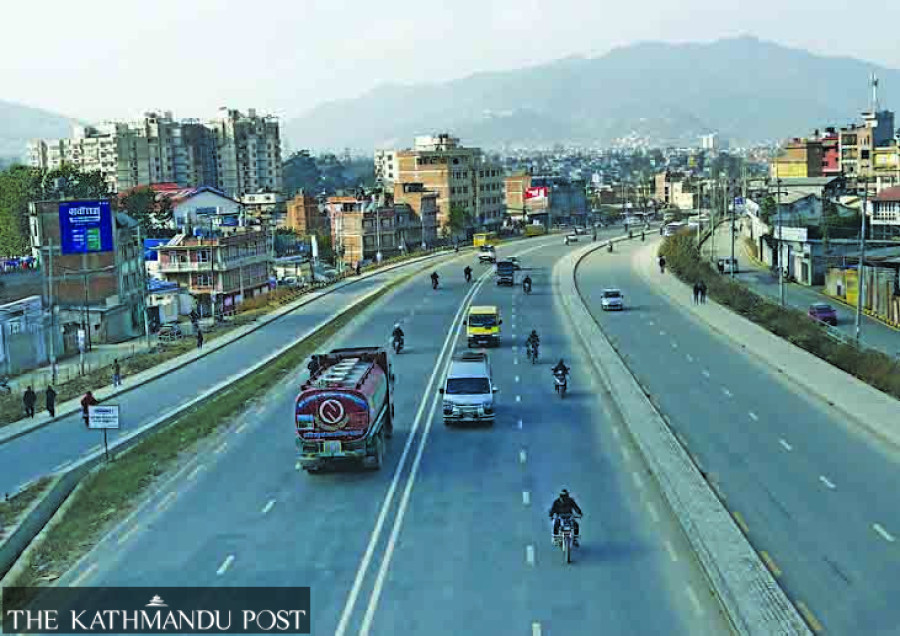Valley
Second phase of Ring Road widening project likely to start from mid-November
Department of Roads says the Chinese contractor will start the work after the Chhath festival if the Covid-19 situation improves and things go as planned.
Anup Ojha
Work on the delayed second phase of Ring Road widening project, which involves broadening the 8.2 km Kalanki-Balaju-Maharajgunj section to eight lanes, is likely to start after Tihar and Chhath (mid-November) festivals, according to a senior official at the Department of Roads.
Arjun Jung Thapa, director general of the department, said the Chinese contractor had informed three months ago about the completion of a detailed project report for the work. “The document was in Chinese language, so they had said they would be sending an English translation soon,” said Thapa.
He said the department sent a letter to the Chinese government through the Ministry of Finance two weeks ago to start the work. “If the Covid-19 situation improves, and things go as planned, the Chinese government is likely to start the work after the Chhath festival. They are not here because they know Nepal is having festival holidays soon,” said Thapa.
In July, the Department of Roads had shown concerns over the high-voltage power lines and water and sewer mains in the Samakhusi area and asked the authorities concerned to move them to facilitate the road widening work.
“The power lines have been shifted so we have asked the Chinese government to start the work,” said Thapa. He said the department has already sent a report including pictures of the road section after the removal of power lines to the Chinese government.
The Kathmandu Ring Road Improvement Project has also said that there won’t be any problem if the Chinese government starts its work.
“The road clearance for the second phase of the Ring Road widening work has been completed, except for the high priority electricity lines from Banasthali to Balaju that supply power to Maharajgunj hospitals, Office of the President and ministers’ quarters,” said Arjun Suwal, the immediate past chief of the Kathmandu Ring Road Improvement Project.
The project’s new chief Kuber Nepali said he has yet to join the office.
However, this is not the first time the authorities have claimed that the site is clear for the contractor to start the work. Earlier in 2019, the roads department had said that the two days state visit of Chinese President Xi Jinping had given hope to start the work from early 2020.
“At that time, the site had not been cleared completely and the Covid-19 pandemic also delayed the work. But now the Chinese government has readied the detailed project report, we hope the work will begin after the festivals,” said Thapa.
Nepal went into a nationwide lockdown from March 24 last year and it affected all sectors including infrastructure projects for a year. Then the second wave of Covid-19 gripped the country and prohibitory orders were reintroduced from April 29.
The second phase of Ring Road widening work is also facing a delay as some residents in the Maharajgunj area have refused to vacate their land over compensation disputes. The Kathmandu Metropolitan City has been saying that the issue is being resolved by the District Administration Office, Kathmandu. Meanwhile, locals of Swayambhu area have protested the planned relocation of a Buddhist shrine and Buddha idols of the Swayambhu park. The spokesperson of the Kathmandu Metropolitan City, Ishwor Man Dangol, says the dispute is being resolved through talks with the local residents.
The project had also faced protests in August 2019 from environmentalists, urban planners, students and other campaigners after a large number of trees lining the Ring Road were felled to widen the road.
“Now there will be no obstruction, and we are waiting for the Chinese government to start the work,” said Thapa, the director general of the roads department.
The first-phase of the Ring Road widening work involving the 10.5km Kalanki-Koteshwar section had started in June 2013 and was completed in five years at the cost of Rs5.13 billion. The section was handed over to the Nepal government in June 2019. The work was carried out by Chinese contractor Shanghai Construction.




 10.12°C Kathmandu
10.12°C Kathmandu.jpg)










